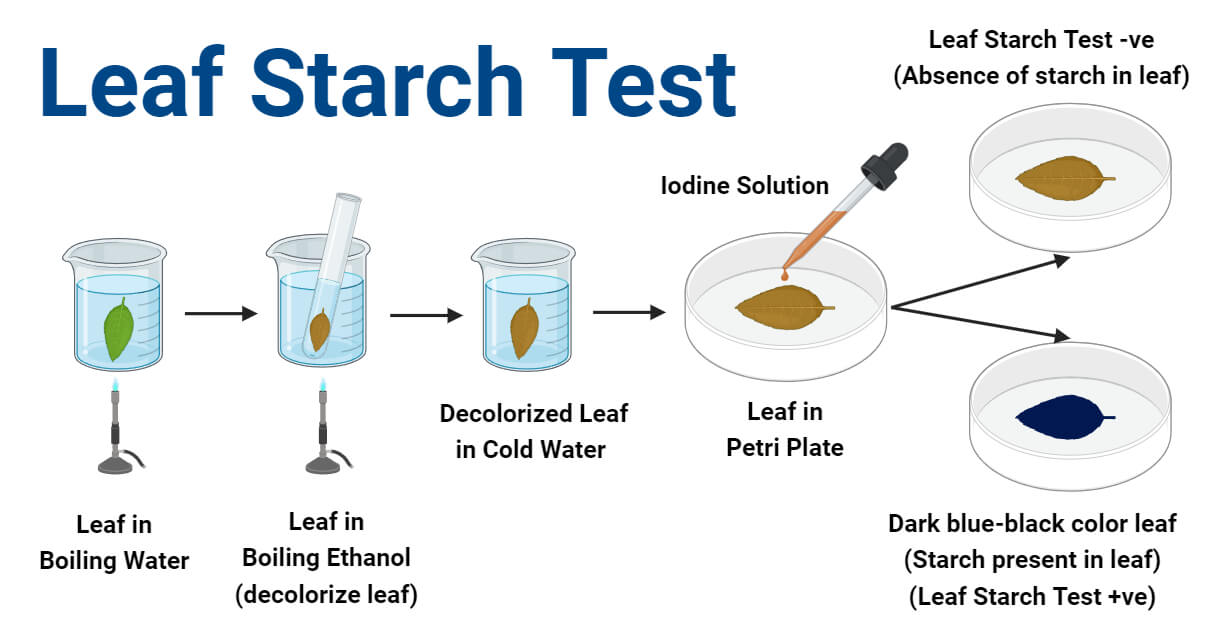Starch in a leaf can be easily detected in a lab with the help of iodine solution. This test is called the ‘Leaf Starch Test’ or ‘Iodine Test for Starch’.
Green leaves are the food factory of plants. Green leaves have abundant chloroplasts – special organelles where the photosynthesis process takes place – so, a large portion of photosynthesis occurs in the leaves of a plant. The glucose produced during photosynthesis is stored as an energy reserve in the form of starch in the leaf, stem, branches, roots, and fruits of a plant. Starch is one of the abundant natural carbohydrates consumed in the diet by humans and other animals as an energy source.
Starch is a complex polymeric carbohydrate (polysaccharide) stored as a reserve food material in plants. It is formed of glucose monomers joined together by a glycosidic bond. The glucose units exist in two forms in natural starch; amylose and amylopectin. Amylose is water insoluble straight-chain polymer of D-glucose subunits linked together by α-1,4 glycosidic bond. Amylopectin is a water-soluble branched chain polymer of D-glucose subunits linked together by α-1,6 glycosidic bond.
Interesting Science Videos
Objectives of Leaf Starch Test
- To detect the presence of starch in a leaf
- To assess the extent of photosynthesis occurring in the leaf
Principle of Leaf Starch Test
Iodine is insoluble in water; but when potassium iodide is added, it dissociates into K+ and I-, and the resulting I– reacts with molecular iodine (I2) to form a triiodide complex (I3–). The triiodide complex can further associate with molecular iodine and form pentaiodide complex (I5–) and so on.

The amylose component of starch is arranged in the form of helical coils. When the iodine-iodide solution is added over starch molecules, the negatively charged polyiodide (mainly triiodide, I3–) slips inside the helices of the amylose chain forming a charge transfer complex. Electrons in this charge transfer complex absorb light energy and get excited. This phenomenon is perceived by the human eye as intense blue-black color.
Hence, in the presence of starch, a blue-black colored complex is formed when the iodine-iodide solution is added over the starch. The intensity of the blue-black color is proportional to the quantity of amylose (or starch) but doesn’t give an exact quantitative (concentration) value. Hence, the test is a qualitative type test.
Requirements for Leaf Starch Test
| Beaker Petri plate Test tube Burner Dropper Forceps | Water Ethanol Lugol’s Iodine Solution Freshly plucked leaf (green leaf of an outdoor plant) |
Procedure of Leaf Starch Test
- Pluck a green leaf of any outdoor plant. A medium size leaf, preferably, a leaf recently exposed to sunlight is better for this test.
- Boil about 250 mL water in a beaker and put the leaf in the beaker and let it boil for a few minutes (2 to 5 minutes) till its waxy coat got off and it gets soft.
- Using forceps, take out the leaf and spread it on a petri plate.
- Place the leaf in a test tube and pour ethanol (90% or more v/v) till the leaf submerses.
- Place the test tube in the beaker with boiling water (or in a water bath) and let the ethanol boil till the leaf decolorizes. Take out the leaf after 5 to 10 minutes if it doesn’t decolorize completely.
- Place the leaf on a petri plate and spread it properly and rinse with cold water.
- Using a dropper, add a few drops of iodine solution over the leaf to cover it.
- Examine the color of the leaf after 2 minutes of the addition of iodine solution.

Observation of Leaf Starch Test
- The leaf will decolorize and become whitish after boiling in an ethanol solution.
- The leaf will turn dark blue-black color after the addition of iodine solution.
Result and Interpretation of Leaf Starch Test
The development of a blue-black color over the surface of the leaf indicates the presence of starch in the leaf. It suggests that the leaf was undergoing a photosynthesis process and had starch within it.
Precautions
- Use forceps to place a leaf in and out of the boiling water and ethanol solution.
- Always use green leaves exposed to sunlight for better results.
- Do not direct the mouth of the test tube with ethanol towards your face while boiling it.
Uses of Leaf Starch Test
- In the assessment of the photosynthetic activity in leaves.
- It is used to study photosynthesis patterns, starch accumulation, and depletion patterns in leaves, and assessment of environmental factors influencing photosynthesis and starch accumulation.
- It is used as a teaching tool for basic-level students to introduce them photosynthesis process in leaves and carbohydrate storage.
Limitations of Leaf Starch Test
- It is a qualitative test and hence only indicates the presence or absence of starch but doesn’t represent the quantity of starch present.
- This test can be easily influenced by exposure of the leaf to sunlight, condition of the leaf, and quality and quantity of iodine solution.
References
- https://www.bbc.co.uk/bitesize/guides/zpcvbk7/revision/3
- https://practicalbiology.org/standard-techniques/testing-leaves-for-starch-the-technique
- https://www.wikihow.com/Test-for-Starch
- https://chem.libretexts.org/Bookshelves/Biological_Chemistry/Supplemental_Modules_(Biological_Chemistry)/Carbohydrates/Case_Studies/Starch_and_Iodine
- https://www.biologyonline.com/dictionary/iodine-test
- https://microbiologynote.com/iodine-test/
- https://learning-center.homesciencetools.com/article/test-for-starch-photosynthesis/
- https://science.cleapss.org.uk/resource-info/pp088-testing-leaves-for-starch.aspx

Wow it is so very good
This site is so helpful. Thank you a million